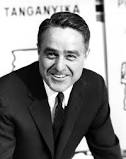A Shriver Idea Finds a Home at the Peace Corps
Peace Corps Prep– Shriver & Clayton Kennedy
“The Peace Corps is a way in which American students can put their studies of other cultures to effective use. The problem, therefore, is how to channel these students toward Peace Corps service. It would be of immeasurable help to the Peace Corps if the colleges and universities of this country would institute a Peace Corps preparatory program in which students could enroll before their service with us. In most schools this would merely be bringing together in one package of already existing courses. In others it could mean the establishment of new courses of instruction….”
Sargent Shriver
Institute of Higher Education Board
Nashville, Tennessee
July 24, 1961

Clayton Kennedy (El Salvador 2010-12)
The head of an office at the Peace Corps called the Office of University Partnerships is Clayton Kennedy, an RPCV who is developing the Peace Corps Prep Program. What, you ask, is the Peace Corps Prep Program.
The Peace Corps Prep idea was first proposed by Sargent Shriver in 1961. Those of us who were around at the time remember in the early ’60s how colleges and universities doing Peace Corps Training had ATP programs where juniors came to summer training and then returned for their senior year, and the following summer did more training, on campus and overseas. We had such a program, run by UCLA, for Ethiopia. I was in charge of one such Training Program for Ethiopia ATPs in 1964-65.
This current incarnation of that idea–Peace Corps Prep– was launched in 2007 and grew slowly over the next several years, starting with eight partner colleges and universities. Today the program has over fifty colleges and universities enrolled.
According to Kennedy, “Although many of the university program do have RPCVs serving in key coordination and teaching roles, that’s not a requirement. And while some universities do create new courses specifically for Peace Corps Prep, that is also optional. Our goal is to help universities coalesce all their relevant curricular and extracurricular opportunities into a straightforward map for students. Students take their PC Prep guide and create a clear plan for how to become a highly qualified candidate for the Peace Corps (or similar) service.
Some of the institutions now offering such a program are: Elon University, Knox College, Pittsburg State University, Shawnee State University, University of Missouri, University of Montana, University of North Georgia and Wittenberg University. Newer schools are: Arcadia University; Georgia Gwinnett College; Hiram College; University of Washington, Tacoma; Ursinus College; and Wilmington College.
Clearly, these are not “named” institutions in the U.S., but that is okay. As the Peace Corps Director Carrie Hessler-Radelet says, “This program is a wonderful example of our growing efforts to foster stronger collaboration with colleges and universities nationwide to prepare civic-minded students for international service.”
This is a very good idea for educating students about the Peace Corps. I have strongly urged Kennedy to get the memoirs by RPCV writers into the hands of students, and I would urge RPCV writers to reach out to his office and send them a copy of their book. If that fails to get Volunteers, then send Clayton around to all these colleges. Once he is on campus, I’m sure, enrollment will increase in the Peace Corps Prep Program, if only among co-eds.
The programs in the 60s, as I remember, were for applicants who had already been accepted for training. Trainees spent the
summer between their junior and senior years in a training program and underwent “selection.” At the end of that period, trainees who had been “selected in” knew that they would join the Peace Corps when they graduated. These programs were country and skill specific. Peace Corps Prep appears to be very general and is not skill nor country specific.